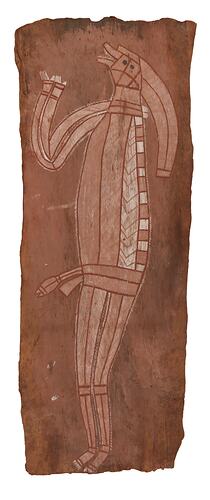Summary
Museums Victoria holds significant collections of artworks by Australian Aboriginal artists dating from the nineteenth and early twentieth centuries. This painting is amongst the earliest works collected by the director of the National Museum of Victoria, Walter Baldwin Spencer, who went to Oenpelli in 1912. Oenpelli was a pastoral lease taken up in 1906 by the legendary Northern Territory figure Paddy Cahill. Spencer returned to Melbourne with thirty-eight works on bark that had been removed from the wet season shelters in the area of the East and South Alligator Rivers. The collaboration between these two men over the following decade would result in the commissioning of over 170 bark paintings for the museum. The imagery in the works derive from a vast array of animals that are depicted in the rich rock art of the region, as well as a significant number of spirit figures known to bining, the people of western Arnhem Land. The bark paintings in the Spencer Collection and the Paddy Cahill Collection are considered the most significant historical art works from western Arnhem Land, and often feature in national and international exhibitions and publications. These paintings take pride of place amongst the extensive and significant holdings of Aboriginal art in the Indigenous collections at Museums Victoria. The only earlier known bark paintings are in the Macleay Museum in Sydney and date from 1878 and were collected at Port Essington.
Physical Description
A single sheet of eucalyptus bark, stringybark (Eucalyptus tetrodonta), painted with natural pigments. The image of a single male spirit figure.
Significance
This spirit figure lives amongst the caves in the country of the 'tribe' that Baldwin Spencer identified as 'Geimbo'. These are in fact Erre, Mengerridji and Urningank people and traditional owners for the area around Oenpelli. Baldwin Spencer identified the figure as Baldwin Spencer identified the figure as 'Nangintain' noting that it 'lives in caves amongst the hills and is very mischievous, roaming about during the night time, and capturing the Iwaiyu, or spirit part of boys who venture away from the camp, or make too much noise'. The depiction here is unusual in that it is a side view rather than the typical front view of the figure. However it conforms with the prominent and distinctive head and facial features that typically distinguish each spirit figure. Black pigment has also unusually been used to exaggerate the eyes, and what Spencer noted as the 'double projection from the back of the head represents two long ears'. Another typical feature of these figures is additional and exaggerated digits on the hands and feet, however it is not the case with this work.The geometric patterning reveals the backbone and rib cage conforming to the classic practice of 'x-ray' art from western Arnhem Land.
More Information
-
Object/Medium
Painting, bark
-
Maker
-
Cultural Groups
-
Locality
Oenpelli, Western Arnhem Land, Northern Territory, Australia
-
Date Produced
-
Collector
-
Date Collected
-
Object Measurements
1845 mm (Length), 830 mm (Width), 70 mm (Height)
-
Keywords
-
Collection Names
-
Type of item
-
Discipline
-
Category
-
Collecting Areas
Australian Indigenous - Northern Australia and Queensland and Torres Strait Islands
-
Medium
Natural pigments
-
Technique
Painting
-
Support
Eucalyptus bark
